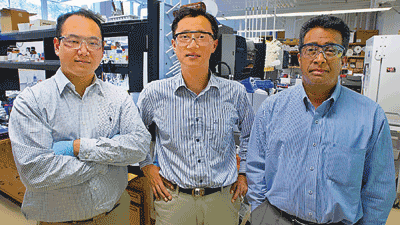LBNL scientists generate electricity from viruses
Device is first to produce electricity by harnessing the piezoelectric properties of a biological material
Scientists from the U.S. Department of Energy’s Lawrence Berkeley National Laboratory are working on a device that will let you charge your phone as you walk, using a paper-thin generator embedded in the sole of your shoe. The power is generated using harmless viruses that convert mechanical energy into electricity.
The scientists tested their approach by creating a generator that produces enough current to operate a small liquid-crystal display. Tapping a finger on a postage-stamp-sized electrode coated with specially engineered viruses convert the force of the tap into an electric charge.

Their generator is the first to produce electricity by harnessing the piezoelectric properties of a biological material. It points to a simpler way to make microelectronic devices. That’s because the viruses arrange themselves into an orderly film that enables the generator to work. Self-assembly is a much sought after goal in nanotechnology.
“More research is needed, but our work is a promising first step toward the development of personal power generators, actuators for use in nano-devices, and other devices based on viral electronics,” says Seung-Wuk Lee, a faculty scientist in Berkeley Lab’s Physical Biosciences Division and a UC Berkeley associate professor. He conducted the research with a team that includes Ramamoorthy Ramesh, a scientist in Berkeley Lab’s Materials Sciences Division and a professor at UC Berkeley, and Byung Yang Lee of Berkeley Lab’s Physical Biosciences Division.
They found that the M13 bacteriophage, which only attacks bacteria and is benign to people, had piezoelectric properties. Being a virus, it replicates itself by the millions within hours, so there’s always a steady supply. It’s easy to genetically engineer, and large numbers of the rod-shaped viruses naturally orient themselves into well-ordered films, much the way that chopsticks align themselves in a box.
The scientists increased the virus’s piezoelectric strength. They used genetic engineering to add four negatively charged amino acid residues to one end of the helical proteins that coat the virus. These residues increase the charge difference between the proteins’ positive and negative ends, which boosts the voltage. The scientists further enhanced the system by stacking films composed of single layers of the virus on top of each other. They found that a stack about 20 layers thick exhibited the strongest piezoelectric effect.

The team created the conditions for genetically engineered viruses to spontaneously organize into a multi-layered film that measures about 1 cm2. This film was then sandwiched between two gold-plated electrodes, which were connected to an liquid-crystal display. When pressure is applied to the generator it produces up to 6 nA at about 400 mV. That’s enough energy to flash the number “1” on the LCD display.
The paper, “Virus-based piezoelectric energy generation,” appeared as an advance online publication on Nature Nanotechnology’s website (www.nature.com/nnano/journal/vaop/ncurrent/full/nnano.2012.69.html).
Jim Harrison